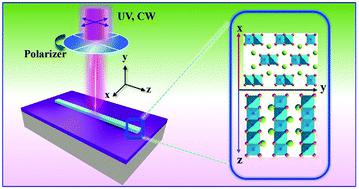当前位置:
X-MOL 学术
›
Mater. Horiz.
›
论文详情
Our official English website, www.x-mol.net, welcomes your feedback! (Note: you will need to create a separate account there.)
Solution-processed one-dimensional CsCu2I3 nanowires for polarization-sensitive and flexible ultraviolet photodetectors
Materials Horizons ( IF 13.3 ) Pub Date : 2020-04-02 , DOI: 10.1039/d0mh00250j Ying Li 1, 2, 3, 4, 5 , Zhifeng Shi 1, 2, 3, 4, 5 , Lintao Wang 1, 2, 3, 4, 5 , Yancheng Chen 1, 2, 3, 4, 5 , Wenqing Liang 1, 2, 3, 4, 5 , Di Wu 1, 2, 3, 4, 5 , Xinjian Li 1, 2, 3, 4, 5 , Yu Zhang 5, 6, 7, 8, 9 , Chongxin Shan 1, 2, 3, 4, 5 , Xiaosheng Fang 5, 10, 11, 12
Materials Horizons ( IF 13.3 ) Pub Date : 2020-04-02 , DOI: 10.1039/d0mh00250j Ying Li 1, 2, 3, 4, 5 , Zhifeng Shi 1, 2, 3, 4, 5 , Lintao Wang 1, 2, 3, 4, 5 , Yancheng Chen 1, 2, 3, 4, 5 , Wenqing Liang 1, 2, 3, 4, 5 , Di Wu 1, 2, 3, 4, 5 , Xinjian Li 1, 2, 3, 4, 5 , Yu Zhang 5, 6, 7, 8, 9 , Chongxin Shan 1, 2, 3, 4, 5 , Xiaosheng Fang 5, 10, 11, 12
Affiliation

|
Recently, much progress has been made in polarization-sensitive photodetectors based on the newly-emerging metal-halide perovskites. However, compared to extensive work on visible/infrared-light photodetection, polarization-sensitive perovskite photodetectors targeted at the ultraviolet (UV) region have not been reported. In addition, most of the previously reported photodetectors concentrated on lead-halide perovskites, but the lead-toxicity and poor stability severely restricted their practical applications. In this study, for the first time, one-dimensional CsCu2I3 nanowires (NWs) were used as the light absorber to fabricate a polarization-sensitive UV photodetector because of their electric and optical anisotropy of the asymmetric structure and external morphology anisotropy, and a high photocurrent anisotropy ratio of ∼3.16 was achieved. Owing to the high crystallinity of the CsCu2I3 NWs, the device exhibits remarkable photodetection ability with a photoresponsivity of ∼32.3 A W−1, a specific detectivity of 1.89 × 1012 Jones, and a fast response speed of 6.94/214 μs. Moreover, such a device fabricated on a flexible substrate shows almost no photodetection degradation after extreme bending for 1000 cycles, demonstrating good flexibility and bending endurance. The results obtained highlight the great potential of such copper halides as a stable and environmentally-friendly candidate for polarization-sensitive UV photodetectors, rendering them potentially useful for assembly of optoelectronic systems in the future.
中文翻译:

溶液处理的一维CsCu2I3纳米线,用于偏振敏感和柔性紫外光电探测器
最近,基于新兴的金属卤化物钙钛矿的偏振敏感光电探测器已经取得了很大的进步。但是,与在可见光/红外光检测方面的大量工作相比,针对紫外线(UV)区域的偏振敏感钙钛矿光电检测器尚未见报道。另外,先前报道的大多数光电探测器都集中在卤化钙钛矿上,但是铅的毒性和较差的稳定性严重限制了它们的实际应用。在这项研究中,第一次是一维CsCu 2 I 3纳米线(NWs)由于其不对称结构的电学和光学各向异性以及外部形态各向异性而被用作光吸收剂,以制造偏振敏感的紫外线光电探测器,并且实现了约3.16的高光电流各向异性比。由于CsCu 2 I 3 NW的高结晶度,该器件具有出色的光检测能力,光响应率为〜32.3 AW -1,比检测率为1.89×10 12Jones,响应速度为6.94 / 214μs。而且,在挠性基板上制造的这种装置在极端弯曲1000次循环后几乎没有显示出光检测性能的下降,证明了良好的挠性和弯曲耐久性。所获得的结果凸显了这种卤化铜作为偏振敏感型紫外线光电探测器的稳定且对环境友好的候选物的巨大潜力,使其在将来可能用于光电系统的组装。
更新日期:2020-04-02
中文翻译:

溶液处理的一维CsCu2I3纳米线,用于偏振敏感和柔性紫外光电探测器
最近,基于新兴的金属卤化物钙钛矿的偏振敏感光电探测器已经取得了很大的进步。但是,与在可见光/红外光检测方面的大量工作相比,针对紫外线(UV)区域的偏振敏感钙钛矿光电检测器尚未见报道。另外,先前报道的大多数光电探测器都集中在卤化钙钛矿上,但是铅的毒性和较差的稳定性严重限制了它们的实际应用。在这项研究中,第一次是一维CsCu 2 I 3纳米线(NWs)由于其不对称结构的电学和光学各向异性以及外部形态各向异性而被用作光吸收剂,以制造偏振敏感的紫外线光电探测器,并且实现了约3.16的高光电流各向异性比。由于CsCu 2 I 3 NW的高结晶度,该器件具有出色的光检测能力,光响应率为〜32.3 AW -1,比检测率为1.89×10 12Jones,响应速度为6.94 / 214μs。而且,在挠性基板上制造的这种装置在极端弯曲1000次循环后几乎没有显示出光检测性能的下降,证明了良好的挠性和弯曲耐久性。所获得的结果凸显了这种卤化铜作为偏振敏感型紫外线光电探测器的稳定且对环境友好的候选物的巨大潜力,使其在将来可能用于光电系统的组装。



























 京公网安备 11010802027423号
京公网安备 11010802027423号